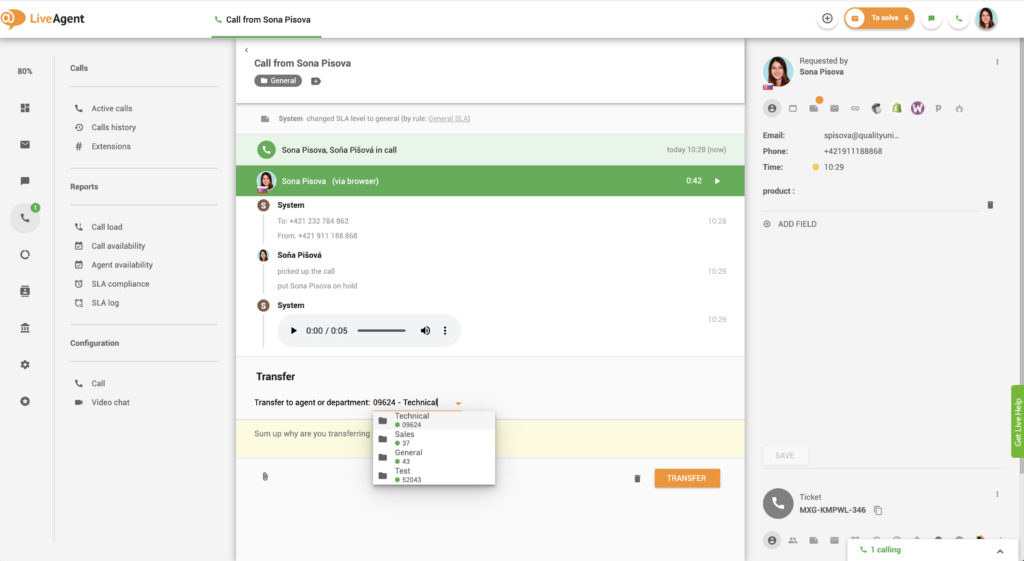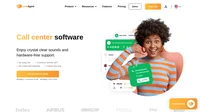What is an attended transfer?
It is a commonly used telecommunications term. It describes a type of phone transfer that puts the caller on hold while a customer support rep communicates with the transfer recipient – another agent. If a transfer destination isn’t available, the initial caller is forwarded to another transfer recipient while still having the caller on the line.
The goal of this type of transfer is to avoid forwarding the original caller to an unavailable customer support agent while keeping transfer waits at a minimum. You can even fill the other agent in on any important information about the customer, ticket, or customer’s inquiry.
In LiveAgent, the attended transfer option waits until it is picked up, rejected, or simply not answered. If that is the case, the call is transferred to another agent.

Benefits of an attended transfer
- Lower abandonment rate – If a customer doesn’t reach the desired agent or department on the first try, or they contact an unavailable representative, they might leave and not come back. This transfer method allows you to forward them right to the person they need to talk to.
- Higher customer satisfaction levels – When clients don’t have to spend time on hold just to get forwarded around results in a frustrated caller. With the attended transfer method, the waiting times are reduced and the chances of reaching an informed person that can help them resolve their issues are much higher.
- Increased productivity – When agents can get valuable details before picking up a forwarded call, they can improve their call resolution rates. Moreover, keeping the customer on the line while communicating with other agents is an effective way of reducing agents’ idle time.
- Lower average handle time – Forwarding incoming calls to available and well-informed agents can significantly reduce the average handle time in your contact center.
Frequently Asked Questions
What is an attended transfer?
This transfer method waits during incoming calls to end a call until it is answered, rejected or missed by the transfer recipient. Your agents don't have to make your customers wait unnecessarily. The caller is placed on hold and the connection is established with the agent. If the agent fails to answer, the call is returned to the previous agent.
How to issue an attended transfer?
If you want to start the transfer process during a conversation with a client, start by selecting a connection with another agent while keeping the caller suspended. The new connection is then active and the first is placed on hold.
Who can assist or serve an attended transfer?
In LiveAgent, an attended transfer can be handled by any agent connected to the system. This is a function that enables more effective customer service and higher productivity.
After reading about attended transfers, you might want to explore more about "What are Call Transfers?". This article dives into the different types of call transfers, including attended transfers, and explains how they can benefit both customers and agents. Additionally, learn about "Benefits of Attended Call Transfers" to understand how they can increase customer happiness and allow agents more time to prepare for calls. These insights can help you enhance your customer service interactions and improve overall efficiency.
LiveAgent monthly updates: April edition
Discover LiveAgent’s April updates: chat fixes, improved ticket sorting, API enhancements & a new HelpDesk migration plugin. Read more!

 Български
Български  Čeština
Čeština  Dansk
Dansk  Deutsch
Deutsch  Eesti
Eesti  Español
Español  Français
Français  Ελληνικα
Ελληνικα  Hrvatski
Hrvatski  Italiano
Italiano  Latviešu
Latviešu  Lietuviškai
Lietuviškai  Magyar
Magyar  Nederlands
Nederlands  Norsk bokmål
Norsk bokmål  Polski
Polski  Română
Română  Русский
Русский  Slovenčina
Slovenčina  Slovenščina
Slovenščina  简体中文
简体中文  Tagalog
Tagalog  Tiếng Việt
Tiếng Việt  العربية
العربية  Português
Português 




